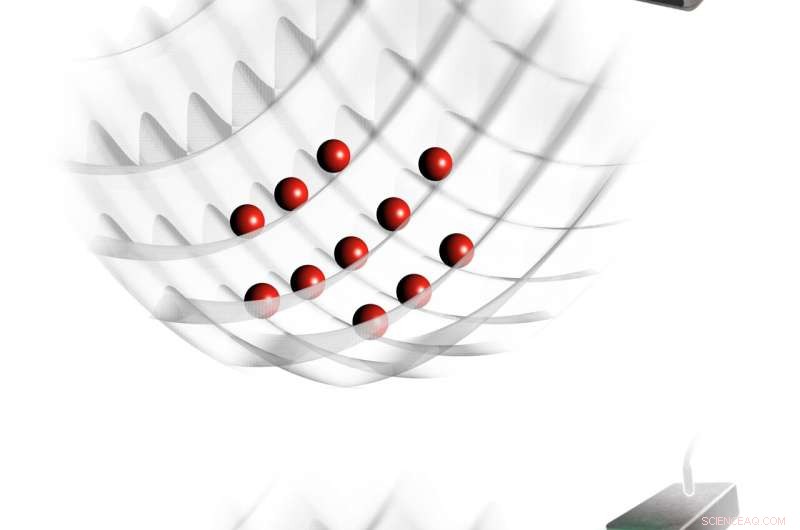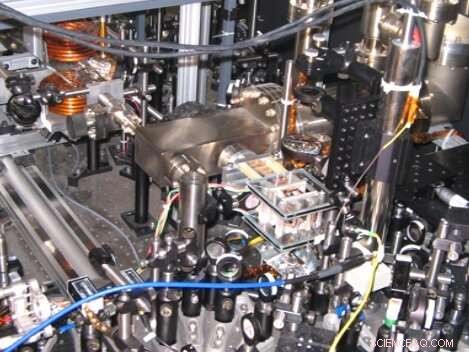
Una representación artística de los resultados de la investigación en el estudio del polaritón muestra los átomos en una red óptica formando una fase aislante (izquierda); átomos que se convierten en polaritones de onda de materia a través del acoplamiento de vacío mediado por radiación de microondas representada por el color verde (centro); los polaritones se vuelven móviles y forman una fase superfluida para un fuerte acoplamiento de vacío (derecha). Crédito:Alfonso Lanuza/Schneble Lab/Stony Brook University.
Los polaritones son cuasipartículas que se forman cuando los fotones se acoplan fuertemente con excitaciones de materia. Estas cuasipartículas, que son mitad luz y mitad materia, sustentan el funcionamiento de una amplia gama de sistemas cuánticos fotónicos emergentes, incluidos dispositivos nanofotónicos basados en semiconductores y sistemas electrodinámicos cuánticos de circuitos.
Investigadores de la Universidad de Stony Brook han introducido recientemente un novedoso sistema de polaritones en el que la excitación de la materia se reemplaza por un átomo en una red óptica y el fotón por una onda de materia atómica. Este sistema, presentado en un artículo publicado en Nature Physics , da como resultado polaritones de ondas de materia y podría abrir interesantes posibilidades para el estudio de la materia cuántica polaritónica.
"Hace unos años, nos interesó la idea de usar átomos ultrafríos para simular el comportamiento dinámico de los emisores cuánticos", dijo a Phys.org el Dr. Dominik Schneble, jefe del equipo de investigadores que llevó a cabo el estudio. "Resulta que es posible construir un átomo artificial que emita espontáneamente ondas de materia, de la misma manera que un átomo emite espontáneamente un fotón (como se describe en el llamado modelo de Weisskopf-Wigner)".
Schneble y sus colegas demostraron que usar un átomo artificial de este tipo en lugar de un 'átomo real' para estudiar el comportamiento dinámico de los emisores cuánticos tenía algunas ventajas. En particular, el sistema artificial permitió a los investigadores ajustar libremente parámetros importantes, como la energía de excitación del emisor y su acoplamiento al vacío.
El emisor artificial que crearon inicialmente consistía en una trampa microscópica (es decir, un pozo de la red óptica), que se llenaba con un solo átomo. El equipo implementó un mecanismo que permitió que el átomo individual cambiara su giro y se liberara espontáneamente en una guía de ondas de materia, en la que se incrustaron las trampas.
"De manera crucial y en contraste con los emisores cuánticos convencionales, este era el único mecanismo de descomposición permitido y la radiación no podía escapar a ningún otro lugar", explicó Schneble. "En un artículo que salió en Nature en 2018, observamos que la descomposición en estas condiciones puede tener características bastante exóticas. En particular, cuando establecemos que la energía de excitación sea negativa (puede sonar extraño, pero también puede ser válido para 'emisores reales' en un material de banda prohibida fotónica), la radiación de onda de materia emitida, que tiene energía negativa, no podría escapar y instead hovered around the emitter as a coherent cloud of vacuum excitations."

An artistic rendering of the research findings in the polariton study shows the atoms in an optical lattice forming an insulating phase (left); atoms turning into matter-wave polaritons via vacuum coupling mediated by microwave radiation represented by the green color (center); polaritons becoming mobile and forming a superfluid phase for strong vacuum coupling (right). Credit:Alfonso Lanuza/Schneble Lab/Stony Brook University.
In their new study, Schneble and his colleagues leveraged the fact that the emitters they had implemented (i.e., the wells) were indeed part of a periodic lattice that can also contain many atoms. As a result, transport and interaction effects inside the lattice can become important.
"If we for a moment neglect the emission features but just look at the lattice, these atoms can by themselves tunnel, or hop, from site to site," Schneble said. "Whether or not this happens depends on the strength of the hopping compared to the energy cost due to the repulsion between two or more atoms on the same lattice site (this is known as the Bose-Hubbard model)."
The key objective of the researchers' study was to determine what happens when they turned on the emission features on their optical lattice system, especially at a negative energy where radiation cannot escape. Interestingly, they found evidence that hovering matter waves tended to leak into neighboring wells.
In a neighboring well, an inverse decay (i.e., absorption) process can convert the hovering matter wave back into a trapped atom. Through this process, the originating well simultaneously empties out.
"This effectively means that the trapped atom, dressed in the matter-wave cloud, has an additional mechanism to hop between lattice sites," Schneble said. "On the other hand, the matter waves in the waveguide can never freely travel on their own and, being chained to the atoms in the lattice, all they can do is hop along."
As a result, in this system the matter waves become less mobile, or "heavier," while the atom becomes more mobile, or "lighter." The matter waves and the atoms in the lattice form composite quasiparticles that carry aspects of both its constituents, dubbed "matter-wave polaritons."

The ultracold-atom apparatus with which the matter-wave polariton experiments were performed. Credit:Schneble Lab/Stony Brook University.
"What makes this system interesting is that the atoms in the lattice (which one might themselves call 'excitations of the empty lattice') repel each other on the sites," Schneble explained. "Now, if matter waves are bound to those atoms, then there is also an effective repulsion between the matter waves. Translating this back to a conventional polariton system in which you replace our matter waves with photons and the hopping atoms in the lattice with exciton polaritons (or other matter excitations), now you have at your disposal an effective repulsion between photons."
On their own, photons are known not to interact with each other. The strong polariton interaction unveiled by the researchers is thus very interesting when extrapolated to a conventional system.
"The unique feature of our platform is that the matter-wave polaritons are loss-free, in contrast to photon-based polariton systems, whose lifetime is limited by spontaneous radiative decay into the environment," Schneble said.
Similarly to their earlier studies focusing on spontaneous decay, the recent polariton work by this team of researchers opens new possibilities for accessing parameter regimes that have so far been inaccessible using conventional photon-based systems. In the future, it could thus enable in-depth explorations of polariton physics in new regimes.
"Our research allows for studies of polaritonic systems with the high flexibility and control of an analog quantum simulation," Schneble added. "Because of the absence of uncontrolled radiative losses, it is generally quite interesting to explore strongly coupled radiative systems with matter waves, and polariton features will play an important role in such studies. Of course, polaritonic platforms themselves have high relevance for applications in QIST, and our work should be of interest in this context as well."
© 2022 Red Ciencia X Discovery of matter-wave polaritons sheds new light on photonic quantum technologies